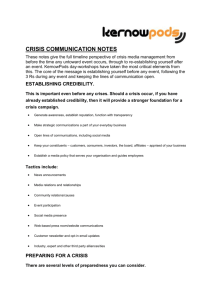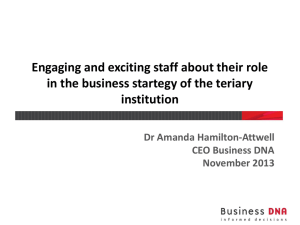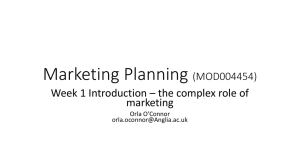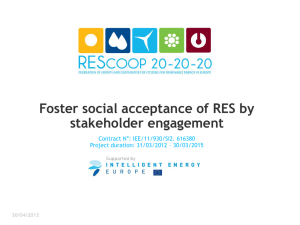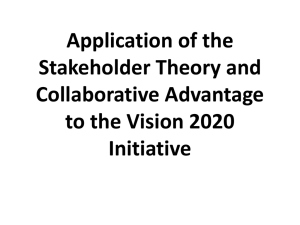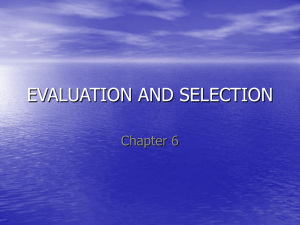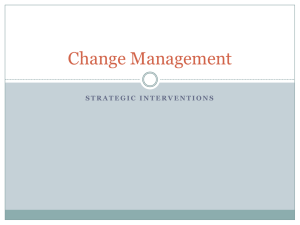Powerpoint slide template (QUT Business School)
advertisement
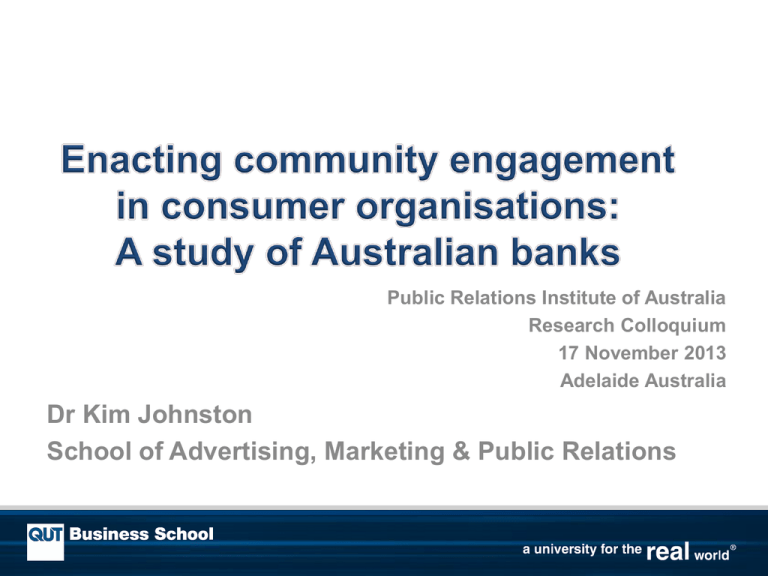
Public Relations Institute of Australia Research Colloquium 17 November 2013 Adelaide Australia Dr Kim Johnston School of Advertising, Marketing & Public Relations Why engagement? • Proposed as new PR paradigm (Edelman, 2008, Stoker & Tusinski, 2006) • Leads to more satisfactory relationships (Bortree, 2011) • Reduces and enhances pro-social relationships between an organisation and its consumers (Bruce & Shelly, 2010) • Public dialogue proposed as a (one of) means of engagement (see for example Taylor, 2004) • Conceived as a mutually oriented state of mind that is willing to give their whole selves to communication encounters (Kent and Taylor, 2001) Engagement - public relations • Definitional ambiguity – Levels (individual and group), theory and guidance – Perspectives • Instrumental (managerial) • Psychological Community Engagement • Originated in participatory democracy – Citizen participation seen as normative and pragmatic – Viewed as fashionable in public policy discourse • Concepts of participation, involvement and engagement e.g.: – Stakeholder engagement – Corporate social responsibility – Community building, involving, and proactive (Hallahan, 2004) • As empowerment or as communication? – Public participation – Consultation (dialogue) – Information Community Engagement • A process for organisations to involve publics – Socially-inclusive & responsive form of organisational decision-making – engaging a community for specific programs can lead to better organisational & social outcomes Consumer organisations “engaging” • A “societal” process – “by which individuals & groups obtain what they need & want through creating, offering & freely exchanging products & services of value with others” (Kotler, 2000, p. 4) • Marketing shifts – shift to a co-creation perspective – value is created & shared by stakeholders (Gamble & Gilmore, 2013). – failure by marketers to see the broader societal context of business decision making, sometimes with disastrous results for their organization and society. (Smith, Drumwright, & Gentile, 2010, p. 4) Narratives in community engagement • An organization’s CSR efforts – "directed towards individual citizens & community groups” (Bowen et al., 2010, p. 297) – CSR - the duty to meet or exceed stakeholder norms dictating desirable organisational behaviours (Maignan and Ferrell, 2004, p. 5). • Public opinion – Alignment with, or reflective of, public demands and expectations • products, services, actions, decisions, brand(s), values, image, reputation, and CSR policies… and pressing issues (Vallentin, 2009, p. 72) Research questions • RQ1: How is community engagement conceptualised in the Australian banking industry? • RQ2: What tactics are used to engage communities? • RQ3: How are community engagement activities reported? • RQ4: What are the dominant themes that emerge in community engagement activities in Australian banks? Model and Propositions P1 The organisation will act to influence the public opinion environment through a range of tactics P5 Organisation P2 The social/ public opinion environment will influence consumer & stakeholder opinions P3 The social/ public opinion environment will influence the nature of products & services offered – level of impact will vary according to nature of business P1 Product/ Service P4 P3 Social – public opinion environment P2 Consumer retailer supplier distributor P4 The organisation will target consumers mindful of social expectations & norms P5 Community engagement framework is a marketing orientation that acts to influence the social public opinion environment Model: community engagement marketing orientation Method • Historical and comparative • Four major banks – ANZ, CBA, NAB, Westpac • The unit of analysis – published community engagement chapter, section, or strategy/ framework/ principles • *Engagement terms (varied: engagement/ sustainability/ community) – public documents sourced from corporate website • Coding instrument (Nvivo 10) – descriptive and topic categories • normative use of terms, philosophies, characterisations, message framing, tactics used to engage with community members. – Interpretive - relationships Analysis & findings RQ 1: How community engagement is conceptualised, or talked about • A strategy - ‘framework’ or ‘principles’ • Purpose (by strength of themes) 1. Anticipate, identify, respond to & “shape” social issues • Achieve shared meaning through listening & dialogue 2. Be an active & responsible member of the community • capacity building • creating value for people wider community • investment in the community • responsibilities to communities - social outcomes - "Make a difference“ 3. Connecting with local community • “Supporting”… general & specific i.e. Indigenous • “Grass roots” partnerships RQ 2: Tactics used to engage communities • High degree of similarity across all banks • Variation in “language” used to describe activities – Philanthropy • Volunteering • Sponsorships – Specialist programs • Indigenous inclusion* (one only) • Disaster relief – Resources given • Education programs i.e.: microfinance • “investing” in communities – Consultation • Formal • Relationship building – External advisory groups • Customer/ community/ indigenous/ expert/ celebrity i.e.: Tim Costello • Workshops and public forums – Research • Focus groups • Formal surveys – Employees* • Engagement surveys RQ 3: Reporting of community engagement activities 1. Sustainability reporting – CSR benchmarks 2. Financial spend – Money “spent” on community __________________________ 3. Community contribution – Sponsorships and programs RQ 4: Dominant themes Four dominant themes (equal representation) 1. 2. 3. 4. Anticipate “big” shifts in demographic and cultural change – consumer expectations – Environmental – Issue identification (scanning and response) Financial outcomes Satisfy industry, government and social expectations Good corporate citizen (rhetoric – reputation based) – Responsive to social needs • Helping and Listening – Contributing to society – Responsible – Attractive employer – CSR established and reported Discussion • Corporate narratives – Demonstrate proactive behaviours • Issues management and control – Corporate focused • Good corporate citizen – “We did good!” • Evidence of genuine community involvement – Financial measures only • Community voice – Panels and committees – Resources provided • Community “partnerships” – “grass roots” Discussion (cont) • Insight into how consumer organisations’ conceptualise engagement – Perception of good corporate citizen – “Doing right by doing good” • Evidence of orchestrating program to respond to public opinion – Social issues salient to local communities • Bullying and mental health issues Propositions P1 & P2: • The organisation will act to influence the public opinion environment through a range of tactics; The social/ public opinion environment will influence consumer & stakeholder opinions - Supported – Recognition of scanning and monitoring by banks – proactive issue identification – Justification of programs and sponsorships (to shareholders) reflecting response (responsiveness) to identified or emergent social issues • P3: The social/ public opinion environment will influence the nature of products & services offered – level of impact will vary according to nature of business – Supported – Financial education programs – Bullying/ social justice/ philanthropic programs – Indigenous and minority groups – Staff philanthropy activities Propositions (cont) • P4: The organisation will target consumers mindful of social expectations & norms – Supported – Regional financial management – Community investment – “Language” choice – Recognition of social expectations • P5: Community engagement framework is a marketing orientation that acts to influence the social public opinion environment – Supported – Evidence of corporate narratives and embedded practice beyond consumer exchange P5 Organisation P1 Social – public opinion environment Product/ Service P4 P3 P2 Consumer retailer supplier distributor Implications • Demonstrates the influence of social and public opinion environment on the organisation-consumer relationships The social environment acts to influence the organisation and the decisions that it makes for both products and services, and the resources, nature, goals for its relationships with customers • Relationship management not new for public relations (role) – New for “product” orientation (dimension of marketing mix) – Translation/ monitoring of public opinion beyond reputation to products and services – Opportunity for public relations Questions Thank you



